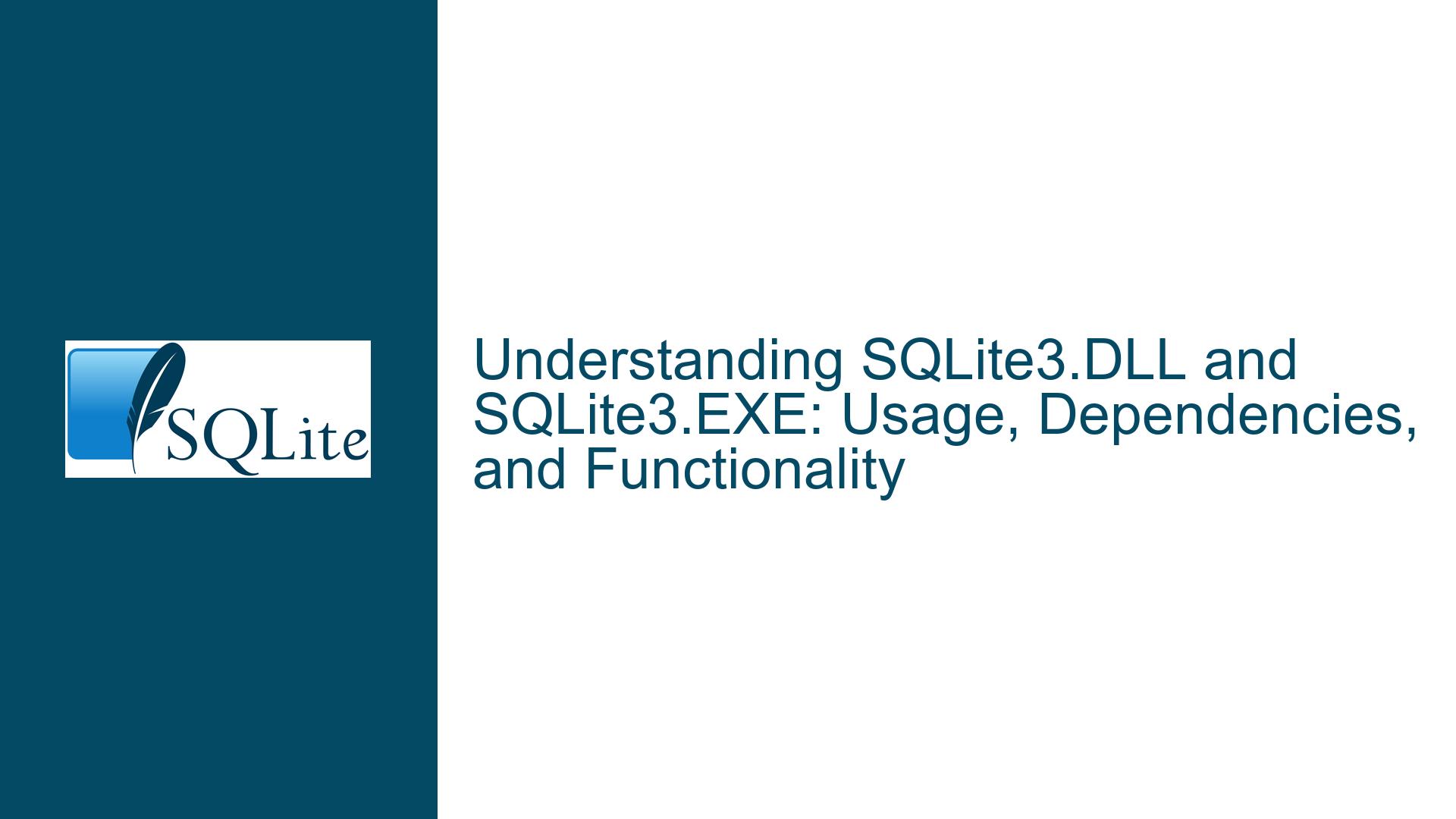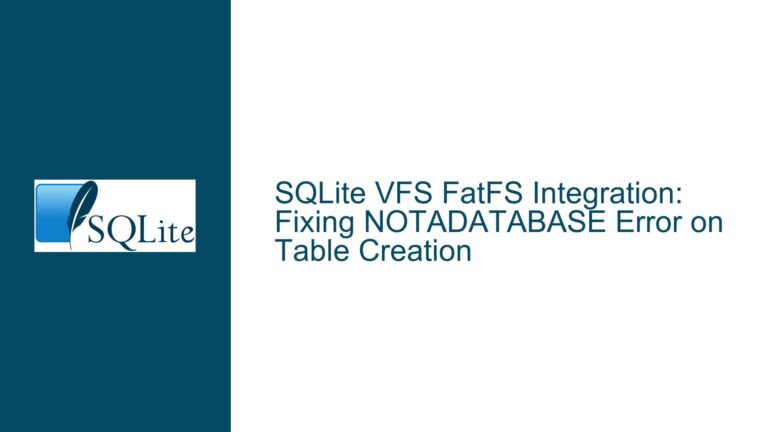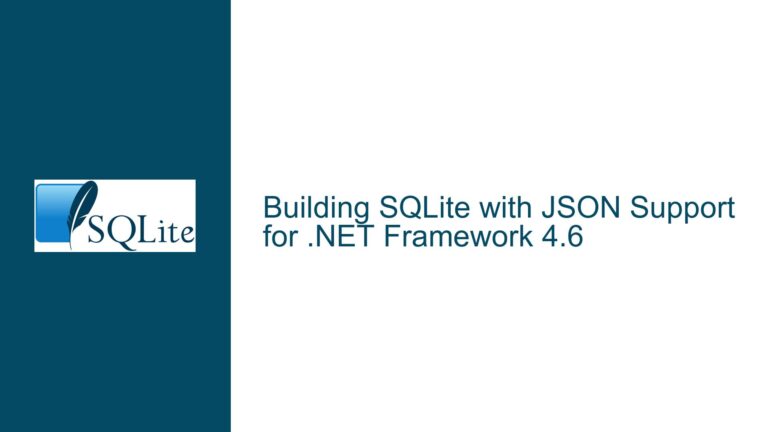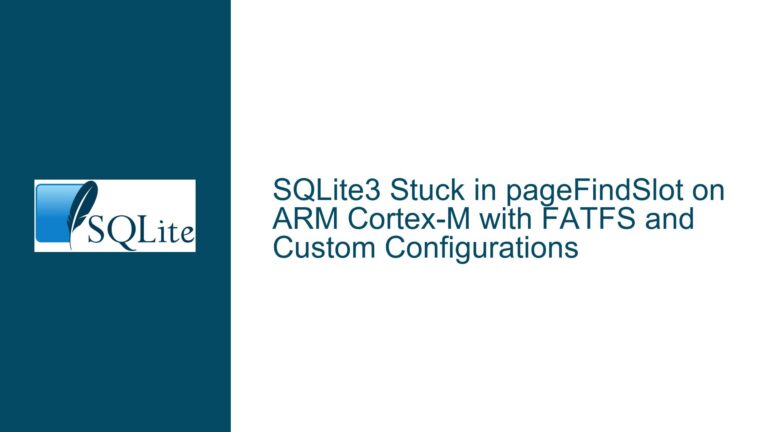SQLite3.DLL and SQLite3.EXE: Usage, Dependencies, and Functionality
SQLite3.DLL and SQLite3.EXE: Core Components and Their Roles
SQLite3.DLL and SQLite3.EXE are two critical components in the SQLite ecosystem, each serving distinct purposes. SQLite3.EXE is the Command Line Interface (CLI) application that allows users to interact with SQLite databases directly through a terminal or command prompt. It is a self-contained executable, meaning it does not rely on external libraries to function. This is evident from the fact that renaming or removing SQLite3.DLL does not affect the operation of SQLite3.EXE. The CLI application is designed to be lightweight and portable, making it an ideal tool for quick database operations, debugging, and scripting.
On the other hand, SQLite3.DLL is a Dynamic Link Library (DLL) that contains the SQLite3 library compiled for Windows applications. This DLL is intended for developers who wish to integrate SQLite functionality into their own applications without statically linking the SQLite library. By using SQLite3.DLL, developers can dynamically link their applications to the SQLite library, allowing for greater flexibility in managing different versions of the library without the need to recompile the entire application. This is particularly useful in environments where multiple applications may need to use different versions of the SQLite library simultaneously.
The distinction between SQLite3.EXE and SQLite3.DLL is crucial for understanding their respective roles. SQLite3.EXE is a standalone application that embeds the SQLite library within itself, making it independent of external dependencies. SQLite3.DLL, however, is a shared library that other applications can link to at runtime, providing SQLite functionality without the need to include the entire library within the application’s executable. This separation of concerns allows for modularity and flexibility in how SQLite is used across different applications and environments.
Dependency Management and Dynamic Linking in SQLite3
One of the key aspects of SQLite3.DLL is its role in dependency management and dynamic linking. When an application is built to use SQLite3.DLL, it relies on the operating system to load the DLL at runtime. This approach has several advantages, including reduced executable size, easier updates, and the ability to share the same library across multiple applications. For instance, if a developer wants to update the SQLite library to a newer version, they can simply replace the SQLite3.DLL file without needing to recompile the application. This is particularly beneficial in large-scale software deployments where managing dependencies can be complex.
The process of dynamic linking involves the operating system loading the DLL into memory when the application starts. The application then calls functions within the DLL as needed. This is in contrast to static linking, where the library code is included directly within the application’s executable. Static linking results in a larger executable size but eliminates the need for external dependencies. In the case of SQLite3.EXE, the SQLite library is statically linked, which is why the executable does not depend on SQLite3.DLL.
To determine whether an application uses dynamic or static linking, tools like Dependency Walker can be used. These tools analyze the executable and list all the DLLs it depends on. In the case of SQLite3.EXE, Dependency Walker would show no dependencies on SQLite3.DLL, confirming that the SQLite library is statically linked within the executable. This information is crucial for developers who need to understand the dependencies of their applications and ensure that all necessary libraries are available at runtime.
Exploring SQLite3.DLL: Functions, Signatures, and Documentation
For developers looking to use SQLite3.DLL in their applications, understanding the functions and their signatures is essential. The SQLite3.DLL contains a wide range of functions that provide access to SQLite’s database engine. These functions are documented in the SQLite C/C++ Interface documentation, which can be found under the "Programming Interfaces" section of the SQLite website. The documentation provides detailed information on each function, including its parameters, return values, and usage examples.
The SQLite3.DEF file, which is often included with the DLL, lists the functions exported by the DLL. However, it does not provide detailed information about the function signatures. To understand the arguments each function takes, developers must refer to the official SQLite documentation. The documentation is comprehensive and covers all aspects of the SQLite C/C++ API, making it an invaluable resource for developers working with SQLite3.DLL.
In addition to the official documentation, developers can also use tools like Doxygen to generate documentation from the SQLite source code. This can be particularly useful for understanding the internal workings of the library and for exploring advanced features that may not be covered in the official documentation. By combining the official documentation with generated documentation, developers can gain a deep understanding of the SQLite3.DLL and how to use it effectively in their applications.
Implementing SQLite3.DLL in Custom Applications
Implementing SQLite3.DLL in custom applications involves several steps, starting with linking the application to the DLL. This can be done using the appropriate linker settings in the development environment. For example, in Visual Studio, developers can specify the SQLite3.DLL as an additional dependency in the project settings. Once the application is linked to the DLL, developers can start using the SQLite functions in their code.
The first step in using SQLite3.DLL is to open a database connection. This is done using the sqlite3_open function, which takes the path to the database file and a pointer to a sqlite3 object as arguments. If the database file does not exist, SQLite will create it. Once the connection is established, developers can execute SQL statements using functions like sqlite3_exec or sqlite3_prepare_v2. These functions allow for the execution of both simple and complex SQL queries, as well as the retrieval of results.
Error handling is an important aspect of working with SQLite3.DLL. SQLite provides several functions for retrieving error messages and codes, such as sqlite3_errmsg and sqlite3_errcode. These functions can be used to diagnose and handle errors that occur during database operations. Proper error handling ensures that the application can gracefully handle unexpected situations and provide meaningful feedback to the user.
In addition to basic database operations, SQLite3.DLL also supports advanced features like transactions, prepared statements, and user-defined functions. Transactions allow for atomic operations, ensuring that a series of database changes are either fully completed or fully rolled back in case of an error. Prepared statements improve performance by allowing the database engine to compile SQL statements once and execute them multiple times with different parameters. User-defined functions enable developers to extend SQLite’s functionality by adding custom functions written in C or C++.
Best Practices for Using SQLite3.DLL and SQLite3.EXE
When using SQLite3.DLL and SQLite3.EXE, there are several best practices that developers should follow to ensure optimal performance and reliability. First, it is important to keep the SQLite library up to date. The SQLite development team regularly releases updates that include bug fixes, performance improvements, and new features. By using the latest version of SQLite3.DLL, developers can take advantage of these improvements and ensure that their applications are running on a stable and secure foundation.
Another best practice is to use transactions whenever possible. Transactions not only ensure data integrity but also improve performance by reducing the number of disk writes. When a series of database operations are wrapped in a transaction, SQLite can optimize the write operations and commit them all at once, rather than writing to disk after each individual operation. This can significantly reduce the overhead associated with frequent disk I/O.
Prepared statements are another powerful feature that developers should leverage. By using prepared statements, developers can avoid the overhead of repeatedly compiling the same SQL statements. Prepared statements are particularly useful in applications that execute the same query multiple times with different parameters. They not only improve performance but also reduce the risk of SQL injection attacks by separating SQL code from user input.
Finally, developers should always include proper error handling in their applications. SQLite provides robust error reporting mechanisms that can help diagnose and resolve issues quickly. By checking the return values of SQLite functions and using functions like sqlite3_errmsg and sqlite3_errcode, developers can ensure that their applications can handle errors gracefully and provide meaningful feedback to users.
Conclusion
SQLite3.DLL and SQLite3.EXE are essential components of the SQLite ecosystem, each serving distinct but complementary roles. SQLite3.EXE provides a standalone CLI for interacting with SQLite databases, while SQLite3.DLL enables developers to integrate SQLite functionality into their own applications through dynamic linking. Understanding the differences between these components, their dependencies, and their usage is crucial for developers working with SQLite.
By following best practices such as keeping the library up to date, using transactions and prepared statements, and implementing proper error handling, developers can ensure that their applications are efficient, reliable, and secure. Whether you are building a small utility or a large-scale application, SQLite3.DLL and SQLite3.EXE offer the flexibility and performance needed to manage your data effectively.






